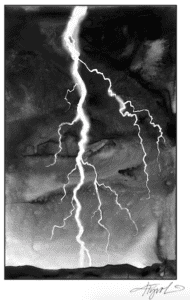The unexpected chemistry of lightning
By Kenrick Vezina
To say that lightning “splits” the sky is no mere poetry. A single stroke contains about one billion joules of energy, roughly 280 kilowatt-hours of electricity, and could power a modern American household for more than nine days. What’s more, it’s enough to blast apart the very molecules that make up the atmosphere and temporarily scramble its composition.
One of these molecules is oxygen. Oxygen in the atmosphere is diatomic, meaning it normally exists as pairs of oxygen atoms with a strong double bond. But lightning rips these paired atoms apart, and in the ensuing chaos some abandon monogamy. The result is ozone, composed of three oxygen atoms. Ozone in the stratosphere shields the planet from the carcinogenic effects of too much ultraviolet solar radiation. It’s also behind the “electric tang” in the air after a particularly active lightning storm, or — less dramatically — when using a copier.

Most of the air around us is made of another diatomic molecule: nitrogen. Nitrogen comprises about 78% of the atmosphere, oxygen accounts for about 21%, and the remainder is a grab-bag of gasses, including carbon dioxide. Nitrogen is also one of the most abundant elements in your body. It’s used to construct the paired bases – the “letters” – of DNA. It’s needed to build amino acids, which build proteins, which build … well, ultimately, all life on Earth.
Yet despite its apparent abundance, entire ecosystems can be throttled by low nitrogen availability. That’s because free-floating nitrogen molecules have a powerful triple bond — even stronger than oxygen pairs’ double bond — that makes them so utterly codependent as to render them chemically inert. Atmospheric nitrogen is useless to plants and animals without outside intervention.
And here is perhaps the only context in which a bacterium in the roots of an alfalfa plant, a fertilizer manufacturing plant, and Zeus’s elemental wrath have something in common, they can all “fix” nitrogen. Nitrogen fixation is the process by which atmospheric nitrogen gets split up and recombined with other elements to form compounds that plants and other life forms can utilize.
Among living things, only a limited selection of bacteria and other microorganisms have the biochemical tools necessary to perform nitrogen fixation. Of these, some are found living freely in soil, while others have formed close relationships with plants. The rhizobia bacteria found in nodules on the roots of legumes – peas, the aforementioned alfalfa, and wild species such as American groundnuts – are a prime example. In northern boreal forests, cyanobacteria that colonize mosses are a major source of nitrogen for the ecosystem.
Unsurprisingly, a great deal of today’s nitrogen fixation also occurs in industrial fertilizer factories. They combine nitrogen and methane under high heat and pressure to form ammonia and other compounds. The wide availability of nitrogen — based fertilizers has been a boon to farmers. But, in a classic case of too much of a good thing, the nitrogen — rich runoff from farms can also cause entire lakes to be strangled by algal overgrowth.
Of course, the heat used in the industrial processing of nitrogen is mild compared to the 50,000 -degree Fahrenheit fury of a stroke of lightning. Even nitrogen’s strong triple bond isn’t enough to hold up to such an overwhelming infusion of energy. In the momentary chemical free- for- all following a lightning strike, some newly single nitrogen atoms join up with eligible oxygen atoms to form nitrogen oxides. These get washed out of the air by rain, find their way into the soil, and can be taken up by thirsty plants. The short-term role of lightning in the nitrogen cycle appears to be minor, amounting to little more than an occasional ecological perk, especially in our relatively thunderstorm — poor region. On a deeper timescale, however, lightning’s role was likely fundamental.
Lightning helped shape the chemistry of early Earth, and may well have provided the spark (literally) needed to make essential elements such as nitrogen and phosphorus available to early organisms, before the evolution of nitrogen- fixing bacteria. When we feel the primal frisson only a late -summer thunderstorm can bring, it augurs more than just a break in the heat: it’s the presence of some remarkable – potentially planet — changing – chemistry.
Kenrick Vezina is a freelance writer, naturalist, and raconteur based in the Greater Boston area. Illustration by Adelaide Murphy Tyrol. The Outside Story is assigned and edited by Northern Woodlands magazine and sponsored by the Wellborn Ecology Fund of the N.H. Charitable Foundation: nhcf.org.




